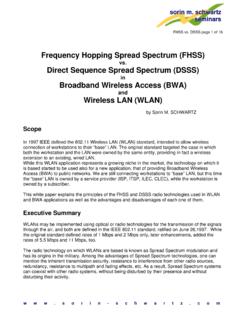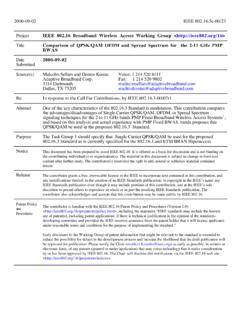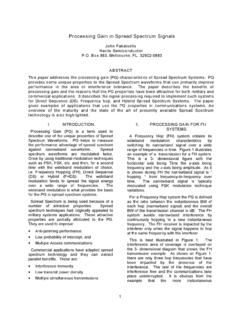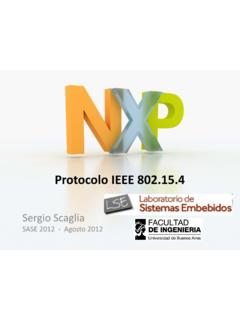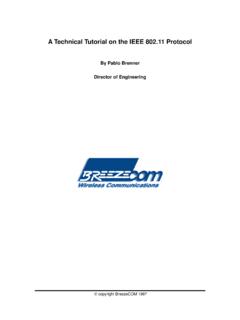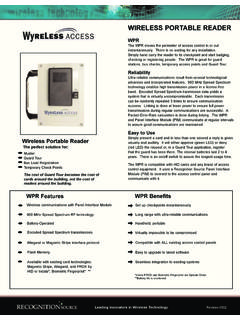Transcription of 2.4 GHz IEEE 802.15.4 / ZigBee-Ready RF Transceiver (Rev. C)
1 CC2420 SWRS041c Page 1 of 85 GHz IEEE / ZigBee-Ready RF Transceiver Applications GHz IEEE systems ZigBee systems Home/building automation Industrial Control Wireless sensor networks PC peripherals Consumer ElectronicsProduct Description The CC2420 is a true single-chip GHz IEEE compliant RF Transceiver designed for low power and low voltage wireless applications. CC2420 includes a digital direct sequence spread spectrum baseband modem providing a spreading gain of 9 dB and an effective data rate of 250 kbps.
2 The CC2420 is a low-cost, highly integrated solution for robust wireless communication in the GHz unlicensed ISM band. It complies with worldwide regulations covered by ETSI EN 300 328 and EN 300 440 class 2 (Europe), FCC CFR47 Part 15 (US) and ARIB STD-T66 (Japan). The CC2420 provides extensive hardware support for packet handling, data buffering, burst transmissions, data encryption, data authentication, clear channel assessment, link quality indication and packet timing information. These features reduce the load on the host controller and allow CC2420 to interface low-cost microcontrollers. The configuration interface and transmit / receive FIFOs of CC2420 are accessed via an SPI interface.
3 In a typical application CC2420 will be used together with a microcontroller and a few external passive components. CC2420 is based on Chipcon s SmartRF -03 technology in m CMOS. Key Features True single-chip GHz IEEE compliant RF Transceiver with baseband modem and MAC support DSSS baseband modem with 2 MChips/s and 250 kbps effective data rate. Suitable for both RFD and FFD operation Low current consumption (RX: mA, TX: mA) Low supply voltage ( V) with integrated voltage regulator Low supply voltage ( V) with external voltage regulator Programmable output power No external RF switch / filter needed I/Q low-IF receiver I/Q direct upconversion transmitter Very few external components 128(RX) + 128(TX) byte data buffering Digital RSSI / LQI support Hardware MAC encryption (AES-128)
4 Battery monitor QLP-48 package, 7x7 mm Complies with ETSI EN 300 328, EN 300 440 class 2, FCC CFR-47 part 15 and ARIB STD-T66 Powerful and flexible development tools available Not Recommended For New Designs CC2420 SWRS041c Page 2 of 85 Table of contents 1 Abbreviations _____ 5 2 References _____ 6 3 Features _____ 7 4 Absolute Maximum Ratings _____ 8 5 Operating Conditions _____ 8 6 Electrical Specifications _____ 9 Overall _____ 9 Transmit Section _____ 9 Receive Section _____ 10 RSSI / Carrier Sense _____ 11 IF Section _____ 11 Frequency Synthesizer Section _____ 11 Digital
5 Inputs/Outputs _____ 12 Voltage Regulator _____ 13 Battery Monitor _____ 13 Power Supply _____ 13 7 Pin Assignment _____ 15 8 Circuit Description _____ 17 9 Application Circuit _____ 19 Input / output matching _____ 19 Bias resistor _____ 19 Crystal _____ 19 Voltage regulator _____ 19 Power supply decoupling and filtering _____ 19 10 IEEE Modulation Format _____ 24 11 Configuration Overview _____ 25 12 Evaluation Software _____ 26 13 4-wire Serial Configuration and Data Interface _____ 27 Pin configuration _____ 27 Register access _____ 27 Status byte _____ 28 Command strobes _____ 29 RAM access _____ 29 FIFO access _____ 31 Multiple SPI access _____ 31 14 Microcontroller Interface and Pin Description _____ 32 Configuration interface _____ 32 Receive mode _____ 33 RXFIFO overflow _____ 33 Transmit mode _____ 34 General control and status pins _____ 35 15 Demodulator.
6 Symbol Synchroniser and Data Decision _____ 35 16 Frame Format _____ 36 Synchronisation header _____ 36 Length field _____ 37 MAC protocol data unit _____ 37 Frame check sequence _____ 38 Not Recommended For New Designs CC2420 SWRS041c Page 3 of 85 17 RF Data Buffering _____ 39 Buffered transmit mode _____ 39 Buffered receive mode _____ 39 Unbuffered, serial mode _____ 40 18 Address Recognition _____ 41 19 Acknowledge Frames _____ 41 20 Radio control state machine _____ 43 21 MAC Security Operations (Encryption and Authentication)
7 _____ 45 Keys _____ 45 Nonce / counter _____ 45 Stand-alone encryption _____ 46 In-line security operations _____ 46 CTR mode encryption / decryption _____ 47 CBC-MAC _____ 47 CCM _____ 47 Timing _____ 48 22 Linear IF and AGC Settings _____ 48 23 RSSI / Energy Detection _____ 48 24 Link Quality Indication_____ 49 25 Clear Channel Assessment _____ 50 26 Frequency and Channel Programming _____ 50 27 VCO and PLL Self-Calibration _____ 51 VCO _____ 51 PLL self-calibration _____ 51 28 Output Power Programming _____ 51 29 Voltage Regulator _____ 51 30 Battery Monitor _____ 52 31 Crystal Oscillator_____ 53 32 Input / Output Matching _____ 54 33 Transmitter Test Modes _____ 55 Unmodulated carrier _____ 55 Modulated spectrum _____ 56 34 System Considerations and Guidelines _____ 57 Frequency hopping and multi-channel systems _____ 57 Data burst transmissions _____ 57 Crystal accuracy and drift _____ 57 Communication robustness _____ 57 Communication security _____ 57 Low-cost systems _____ 58 Battery operated systems _____ 58 BER / PER measurements _____ 58 35 PCB Layout Recommendations _____ 59 36 Antenna Considerations _____ 59 37 Configuration Registers _____ 61 38 Test Output Signals _____ 81 39 Package Description (QLP 48) _____ Error!
8 Bookmark not defined. 40 Recommended layout for package (QLP 48) _____ Error! Bookmark not defined. Not Recommended For New Designs CC2420 SWRS041c Page 4 of 85 Package thermal properties _____ Error! Bookmark not defined. Soldering information _____ 83 Plastic tube specification _____ Error! Bookmark not defined. Carrier tape and reel specification _____ Error! Bookmark not defined. 41 Ordering Information _____ Error! Bookmark not defined. 42 General Information _____ 84 Document History _____ 84 Product Status Definitions _____ Error!
9 Bookmark not defined. 43 Address Information _____ Error! Bookmark not defined. 44 TI Worldwide Technical Support _____ Error! Bookmark not defined. Important Notice _____ Error! Bookmark not defined. Not Recommended For New Designs CC2420 SWRS041c Page 5 of 85 1 Abbreviations ADC - Analog to Digital Converter AES - Advanced Encryption Standard AGC - Automatic Gain Control ARIB - Association of Radio Industries and Businesses BER - Bit Error Rate CBC-MAC - Cipher Block Chaining Message Authentication Code CCA - Clear Channel Assessment CCM - Counter mode + CBC-MAC CFR - Code of Federal Regulations CSMA-CA - Carrier Sense Multiple Access with Collision Avoidance CTR - Counter mode (encryption)
10 CW - Continuous Wave DAC - Digital to Analog Converter DSSS - direct sequence Spread Spectrum ESD - Electro Static Discharge ESR - Equivalent Series Resistance EVM - Error Vector Magnitude FCC - Federal Communications Commission FCF - Frame Control Field FIFO - First In First Out FFCTRL - FIFO and Frame Control HSSD - High Speed Serial Debug IEEE - Institute of Electrical and Electronics Engineers IF - Intermediate Frequency ISM - Industrial, Scientific and Medical ITU-T - International Telecommunication Union Telecommunication Standardization Sector I/O - Input / Output I/Q - In-phase / Quadrature-phase kbps - kilo bits per second LNA - Low-Noise Amplifier LO - Local Oscillator LQI - Link Quality Indication LSB - Least Significant Bit / Byte MAC - Medium Access Control MFR - MAC Footer MHR - MAC Header MIC - Message Integrity Code MPDU - MAC Protocol Data Unit MSDU - MAC Service Data Unit NA - Not Available NC - Not Connected O-QPSK - Offset - Quadrature Phase Shift Keying PA - Power Amplifier PCB - Printed Circuit Board PER - Packet Error Rate PHY - Physical Layer










